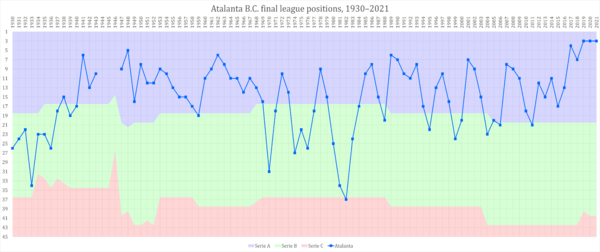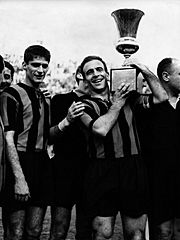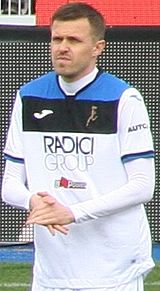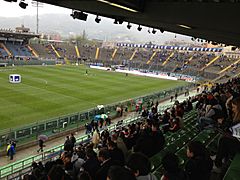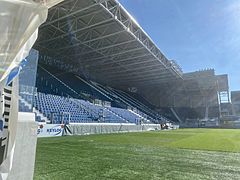Atalanta BC facts for kids
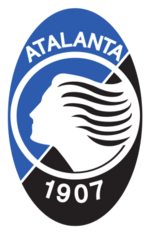 |
||
| Full name | Atalanta Bergamasca Calcio S.p.A. | |
|---|---|---|
| Nickname(s) | La Dea (The Goddess) Gli Orobici (The Orobics) I Nerazzurri (The Black and Blues) |
|
| Founded | 17 October 1907 as SBG Atalanta 30 March 1920 as Atalanta Bergamasca Calcio |
|
| Ground | Gewiss Stadium | |
| Capacity | 24,950 | |
| Owner | La Dea S.r.l. (86%) (Stephen Pagliuca and others 55%; Antonio Percassi 45%) Others (14%) |
|
| President | Antonio Percassi | |
| Manager | Ivan Jurić | |
| League | Serie A | |
| 2018–19 | Serie A, 3rd of 20 | |
|
|
||
Atalanta Bergamasca Calcio, often called Atalanta, is a professional football club from Bergamo, Lombardy, Italy. They play in Serie A, which is the top football league in Italy.
Atalanta was started in 1907. They have played more seasons in Serie A (64) than any other team not from a regional capital city, and they haven't won the league title yet. The club also holds the record for the most promotions to Serie A. They share the record for most Serie B titles with Genoa.
Atalanta won the Coppa Italia in 1963. They also won the UEFA Europa League in 2024. The club has played in the UEFA Champions League four times, reaching the quarter-finals in 2020. They have also played in the UEFA Europa League (formerly UEFA Cup) six times. In 1988, while still in Serie B, they reached the semi-finals of the Cup Winners' Cup. This is one of the best results ever for a team not in the top division in a major UEFA competition.
The team plays its home games at the Gewiss Stadium. Their main uniform colors are black and blue. Atalanta has a big rivalry with their nearby club, Brescia. The club is also famous for its youth academy. This academy has helped many talented players become stars in Europe's top leagues.
Contents
Club History: From Founding to Today
Early Years: Starting and Joining Serie A (1907–1959)
Atalanta was founded on October 17, 1907, by students. They named the club after a female athlete from Greek mythology. It wasn't the first football club in Bergamo, but it quickly became important. In 1919, the Italian Football Federation said only one club from Bergamo could play in the top league. Atalanta won a playoff match against their rivals, Bergamasca.
In 1920, Atalanta and Bergamasca merged. The new club was called Atalanta Bergamasca Calcio. This is when they chose their black and blue (nerazzurri) colors.
Atalanta played in the second division in the early 1920s. In 1928, they won their group and were promoted. They also opened their current home stadium in 1928. In 1929, they joined Serie B, the second tier of the new Italian league.
After almost ten years in Serie B, Atalanta was promoted to Serie A for the first time in 1937. They were relegated that same season but returned to Serie A in 1940 as champions of Serie B.
During the 1940s, Atalanta played well in the top league. Football was paused between 1943 and 1945 because of World War II. In 1948, Atalanta finished fifth in the league, which was their best result until 2017. They became known as the provinciale terribile (terrible provincial team). This was because they often beat famous city teams like the Grande Torino.
Atalanta usually finished in the middle of the table in the 1950s. They stayed in Serie A until 1958. They were relegated due to accusations of unfair play, but these claims were proven false a year later. The club returned to Serie A by winning their second Serie B title.
Winning the Coppa Italia and European Adventures (1959–1994)
Atalanta won their first major trophy, the Coppa Italia, in 1963. They beat Torino 3–1 in the final, with Angelo Domenghini scoring three goals. This win allowed them to play in their first major UEFA competition, the 1963–64 European Cup Winners' Cup. They were knocked out in the first round.
In the 1970s, Atalanta moved between Serie A and Serie B several times. Even when they were in Serie B, they helped develop many young players. Some of these players later won the 1982 FIFA World Cup with Italy.
The club faced a tough time in the early 1980s, even dropping to Serie C1 in 1981. This was the first time they played outside the top two leagues. This challenge helped the club make many changes and improve.
With new leaders, Atalanta quickly won Serie C1 in 1982. They returned to Serie B the next season and then to Serie A in 1984. In 1987, Atalanta reached their second Coppa Italia final but lost to Napoli. Because Napoli also won Serie A, Atalanta qualified for the 1987–88 European Cup Winners' Cup.
This was a big moment for the club. Emiliano Mondonico became the coach. In the Cup Winners' Cup, Atalanta reached the semi-finals, losing to K.V. Mechelen. This was the best performance ever by a team not in their country's top league in a UEFA competition.
Atalanta finished sixth in 1988–89 Serie A, qualifying for their first UEFA Cup. They also reached the quarterfinals of the 1990–91 UEFA Cup in 1991, losing to local rivals Internazionale.
Ups and Downs (1994–2016)
After some good finishes, Atalanta was relegated in 1994. They returned to Serie A in 1995. In the 1995–96 season, they reached the Coppa Italia final again but lost to Fiorentina. In 1996–97, Filippo Inzaghi scored 24 goals, becoming Atalanta's only top scorer in Serie A.
The club then sold some key players, which made them struggle. They went back to Serie B in 1998. In 2000, coach Giovanni Vavassori helped the team get promoted back to Serie A using many young players from the youth academy.
In the 2000s, Atalanta moved between divisions a few times. They were relegated in 2003 and 2005. But each time, they quickly returned to Serie A after just one season in Serie B, winning the Serie B title in 2006.
After a difficult 2009–10 season, the club was relegated again. Antonio Percassi became the new president. The club won Serie B in 2011 and returned to Serie A right away. During this time, the club faced a points deduction in the league due to a past issue. Through the early and mid-2010s, Atalanta usually finished in the lower-middle part of the Serie A table.
Reaching New Heights with Gasperini (2016–Present)
Gian Piero Gasperini became coach before the 2016–17 season. After a tough start, the team improved a lot. Gasperini used many players from the club's youth academy. He led the team to a fourth-place finish in the league, their best ever. This meant they qualified for the 2017–18 UEFA Europa League, their first UEFA competition in 26 years. They reached the round of 32 in the Europa League.
In 2017–18, Atalanta finished seventh, qualifying for the 2018–19 UEFA Europa League qualifiers. Despite a tough start to the 2018–19 season, Atalanta finished third in Serie A. This was their highest league finish ever, and they qualified for the UEFA Champions League group stage for the first time. They also reached the Coppa Italia final but lost to Lazio.
In the 2019–20 season, Atalanta lost their first three Champions League matches. But they still managed to qualify for the round of 16. They beat Valencia to reach the quarterfinals, where they were eliminated by Paris Saint-Germain. The club also finished third in Serie A again, qualifying for the Champions League for a second time.
In the 2020–21 season, Atalanta reached the Champions League round of 16 for the second time. They secured Champions League qualification and third place in Serie A for the third year in a row. They also reached the Coppa Italia final again, losing to Juventus.
In February 2022, a group led by Stephen Pagliuca bought a majority share of Atalanta. Pagliuca became co-chairman, with Antonio Percassi remaining as chairman. Atalanta finished eighth in Serie A in 2022, missing out on European competitions. But they bounced back in 2023 with a fifth-place finish and qualified for the Europa League.
On August 4, 2023, Atalanta started a reserve team in Serie C. In the 2023–24 season, Atalanta reached the 2024 Coppa Italia final, losing to Juventus. They also made their first appearance in a European final, the UEFA Europa League final. In that match, they defeated Bayer Leverkusen 3–0, with Ademola Lookman scoring all three goals. This was their first trophy since 1963. Atalanta also qualified for the 2024–25 UEFA Champions League after three years away.
Team Colors, Kits, and Crest
Team Colors and Kits
When Atalanta first started, their uniforms had thin black and white stripes. These were their colors until 1920. That's when they merged with another local club, Bergamasca, which had blue and white kits. After the merger, the white color was removed. This left black and blue (nerazzurri) as the new colors for Atalanta Bergamasca Calcio.
In the first few years after the merger, the club's kits had black and blue squares. Atalanta started using their classic black and blue vertical stripes a few years later.
Atalanta's home kits have almost always had black and blue vertical stripes since the 1920s. The stripes might change in thickness, but the classic design for home kits stays the same. Atalanta's away kits are usually white, with some black and blue details. The club's third kits and goalkeeper kits have used many different colors over the years, like green, red, light blue, and black.
Since 2010, Atalanta plays its last home game of the year, called a "Christmas Match," in special uniforms. These kits are then auctioned off to raise money for charity.
Team Crest
Atalanta has had five different crests (logos) since it was founded. All of them show the team's name, colors, and, since 1963, the Greek mythological athlete Atalanta. The club is named after her and also gets its nickname La Dea (The Goddess) from her.
The first three crests were shields. They had the name Atalanta at the top, colored stripes on the left, and another symbol on the right. The original crest from 1907 had the club's first black and white stripes with a blue section. In 1963, after winning the Coppa Italia, the crest was changed. It showed black and blue stripes with a running girl, representing Atalanta. The colors and the image of Atalanta changed again in the 1970s, but the basic shield shape stayed the same.
In 1984, the crest was completely redesigned. The club's name and the running girl's body were removed. The shape changed from a shield to a circle. This "classic" crest had a white outline of Atalanta's head on a black and blue background. It was surrounded by three white, black, and golden yellow circles. Black, blue, and white were kept as the club's colors. Yellow was added to represent the golden apples. In mythology, Hippomenes used these apples to distract Atalanta and win a footrace.
The club's current crest was designed in 1993. It includes the 1984 crest but tilts Atalanta's head and doesn't have the yellow circle. The name Atalanta and the founding year 1907 were added above and below the circle. The circle is inside an ellipse with the same black and blue background as the 1984 design.
Home Stadium: Gewiss Stadium
Atalanta has played at its current stadium, the Gewiss Stadium, since 1928. It can hold 24,950 fans and is in the Borgo Santa Caterina neighborhood of Bergamo. Before this stadium, Atalanta played at other fields in Bergamo.
The new stadium was built on Viale Margherita. It replaced a horse racing track. Building the stadium took one year and it opened in 1928. It could hold 12,000 spectators. The stadium was officially opened on December 23, 1928, when Atalanta won a match 2–0.
After World War II, the stadium was renamed the Stadio Comunale (Municipal Stadium). More stands were built in the years after the war. The south stand (Curva Sud) was built in 1949. The north stand (Curva Nord) followed in the 1960s, opening in 1971. In 1984, the running track was removed to make more space for fans. This increased the stadium's capacity. In 1984, a match against Inter had over 43,000 fans, a record for the stadium.
The stadium was renamed the Stadio Atleti Azzurri d'Italia (Blue Athletes of Italy) in 1994. In 1997, the Curva Nord was nicknamed the Curva Pisani to honor 22-year-old forward Federico Pisani, who died in a car accident. In 2012, the Curva Sud was nicknamed the Curva Morosini to honor 25-year-old youth player Piermario Morosini, who passed away during a match. In 2015, the stadium also added seats closer to the field, which was a new feature for Italian stadiums.
On May 10, 2017, Atalanta bought the stadium. This made them one of only four Serie A clubs to own their home stadium. Owning the stadium allowed the club to start a big renovation project. This was needed to update the stadium and meet UEFA standards for hosting European matches. Because the stadium wasn't ready, Atalanta had to play some European home matches at other stadiums.
After a sponsorship deal with the company Gewiss, the stadium was renamed the Gewiss Stadium on July 1, 2019. On October 6, 2019, the renovated Curva Nord was opened. It has covered seating for over 9,000 fans. A year later, both side stands were updated. These improvements allowed Atalanta to play their Champions League matches in Bergamo starting in the 2020–21 season.
The final part of the renovation will include rebuilding the Curva Sud. This will increase the stadium's capacity to about 25,000. It will also include a new underground parking garage and other improvements. Construction is expected to finish by August 2024. Atalanta can still play home matches at the Gewiss Stadium during construction, though with a slightly reduced capacity.
The stadium in Bergamo has also been used by another local club, U.C. AlbinoLeffe, from 2003 to 2019. Atalanta's youth team also sometimes plays competitive matches at the Gewiss Stadium.
Training Ground
Atalanta trains at the Centro Sportivo Bortolotti in Zingonia. This complex was built in the 1960s and bought by president Achille Bortolotti in 1977. The senior team uses it for training and some friendly games. The youth teams use it for training and home matches in youth competitions. Atalanta's famous youth academy is also based in Zingonia. The club has continuously invested in it since it was established.
Atalanta Supporters
As of 2022, Atalanta is the 9th-most supported club in Italy, with about 314,000 fans. While other clubs have more fans, Atalanta's recent success has brought in more support, especially from younger people. The club has also tried to grow its fanbase with the Neonati Atalantini program. Since 2010, this program gives a free Atalanta shirt to every baby born in Bergamo. By 2020, over 36,000 shirts had been given out.
Most of the club's fans live in the Province of Bergamo. There are strong connections between Atalanta and the people of Bergamo. Atalanta supporters (tifosi) are known for being very passionate and loyal. Atalanta's Ultras (most dedicated fans) gather in the Curva Nord as a group called Curva Nord 1907. They are known for being very passionate and sometimes intense.
On match days, the Curva Nord often has flares, fireworks, and special displays (called choreography). Sometimes, a large black-and-blue striped flag covers the stand. In the 2018–19 season, Atalanta home matches had an average of 18,248 fans.
Since 2002, Atalanta fans have organized La Festa della Dea (the Festival of the Goddess) almost every summer. This multi-day festival celebrates the club. It includes music, local food, and honors the club's history, leaders, and players.
Friendships and Rivalries
Atalanta supporters have a long-standing friendship (gemellaggio) with fans of Ternana. This is one of the oldest and strongest friendships between fan groups in Italy. Fans often visit each other's stands. Atalanta fans also have a historical friendship with fans of German club Eintracht Frankfurt. There are also friendly relations with fans of Spezia, Cosenza, Cavese, and Austrian club Wacker Innsbruck.
Atalanta supporters have their most intense rivalry with fans of nearby club Brescia. Matches between these two clubs are sometimes called the Derby Lombardo (Lombard Derby). This rivalry comes from a historical feud between Bergamo and Brescia that goes back to the Middle Ages. Even though the fighting ended, the historical rivalry still makes matches between Atalanta and Brescia very exciting.
Since at least 1977, there has been a strong rivalry between Atalanta fans and Torino. There have been various clashes between the fan groups during matches. Atalanta also has strong rivalries with Italy's other big clubs: Roma, Milan, Inter, Napoli, and Lazio, and Fiorentina. These rivalries are often fueled by historical events, different political views among fan groups, or intense matches. There are also strong rivalries with fans of Bologna, Como, Genoa, Hellas Verona, Pisa, Vicenza, and Croatian club Dinamo Zagreb.
Players
Current Squad
|
|
Atalanta Under-23 Team
Youth Academy
Other Players Under Contract
|
|
Players on Loan
|
|
Retired Numbers
12 – This number is dedicated to the fans, especially those in the Curva Pisani.
14 – ![]() Federico Pisani, a forward who played from 1991–97. This is a special honor after his passing.
Federico Pisani, a forward who played from 1991–97. This is a special honor after his passing.
80 – Elio Corbani, a radio journalist.
Team Managers
Atalanta's current manager (head coach) is Gian Piero Gasperini. He started in this role on June 14, 2016. The club has had 59 managers since they hired their first professional coach in 1925.
Gian Piero Gasperini has managed the most games in the club's history (387 matches as of June 2, 2024). He also has the longest time as Atalanta manager, with seven seasons in a row. He led the club to their highest league finishes and to qualify for the UEFA Champions League between 2019 and 2021.
The second-longest serving manager is Emiliano Mondonico. He managed 299 matches in two different periods (1987–90 and 1994–98). He led the team in the European Cup Winners' Cup and a UEFA Cup. Stefano Colantuono is the third-longest serving manager, with 281 matches in total over two periods (2005–07 and 2010–15).
Coaching Staff
Club Leadership
Club Presidents
Atalanta has had many presidents (chairmen) throughout its history. Some of them were also the main owners of the club. The president who served the longest was Ivan Ruggeri. He was replaced by his son Alessandro in 2008 after he became ill.
In June 2010, after the team was relegated to Serie B again, Alessandro Ruggeri sold his part of the club to Antonio Percassi. Antonio Percassi then became the new chairman of Atalanta.
|
|
Club Achievements
Domestic Titles
League Wins
- Serie B
- Winners (6): 1927–28, 1939–40, 1958–59, 1983–84, 2005–06, 2010–11
- Serie C1
- Winners (1): 1981–82 (Group A)
Cup Wins
- Coppa Italia
- Winners (1): 1962–63
European Titles
- UEFA Europa League
- Winners (1): 2023–24
Team's League History
| Series | Years | Last Season | Promotions | Relegations |
|---|---|---|---|---|
| A | 64 | 2024–25 | — | |
| B | 28 | 2010–11 | ||
| C | 1 | 1981–82 | — | |
| 93 years of professional football in Italy since 1929 | ||||
UEFA Club Ranking
Here's how Atalanta ranks among European clubs by UEFA coefficient points:
| Rank | Team | Points |
|---|---|---|
| 15 | 77.750 | |
| 16 | 76.500 | |
| 17 | 69.000 | |
| 18 | 69.000 | |
| 19 | 67.000 |
Youth System

The Atalanta youth system has several boys' teams that play in national leagues. It also has teams that play at a regional level.
Giuseppe Ciatto was the first person to really focus on setting up Atalanta's youth teams. He handled all the organization and even coached the teams. In 1949, Atalanta won the Campionato Ragazzi (a youth championship).
In the late 1950s, Luigi Tentorio, a former Atalanta player, saw the need to invest more in youth. He decided to create a proper youth sector with its own structure, separate from the main team. This youth sector was led by Giuseppe Brolis, who built a network of scouts and young coaches.
A very important step for the youth sector happened in the early 1990s. President Antonio Percassi started a new plan to invest heavily in youth development. He convinced Fermo Favini to join Atalanta and put him in charge of the youth sector.
The Atalanta youth system not only kept producing players for the main team but also started winning many national titles. From 1991 to 2014, the various youth teams won 17 national championships.
Besides winning titles, the Atalanta youth system is also considered one of the best in Europe. A study ranked Atalanta's youth system as the top in Italy and sixth in Europe. This ranking was based on how many players from the club's youth system went on to play in the top division. For example, in the 2007–08 season, 22 players from Atalanta's youth system played in Serie A.
In 2014, another study placed Atalanta's youth system eighth in the world. This was based on 25 former youth players who were playing in the top 5 European leagues.
On August 4, 2023, Atalanta created a reserve team in Serie C. They were only the second Italian club to do this.
See also
 In Spanish: Atalanta Bergamasca Calcio para niños
In Spanish: Atalanta Bergamasca Calcio para niños


